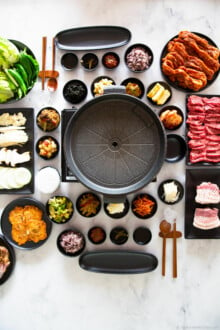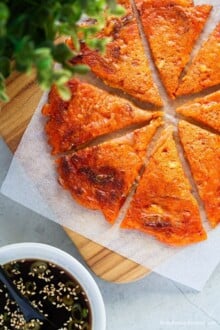Learn how to make delicious dolsot bibimbap, with or without a traditional Korean stone bowl! This iconic rice bowl dish is loaded with vibrant vegetables, savory toppings, and perfectly crispy rice, creating a feast for both the eyes and the taste buds.
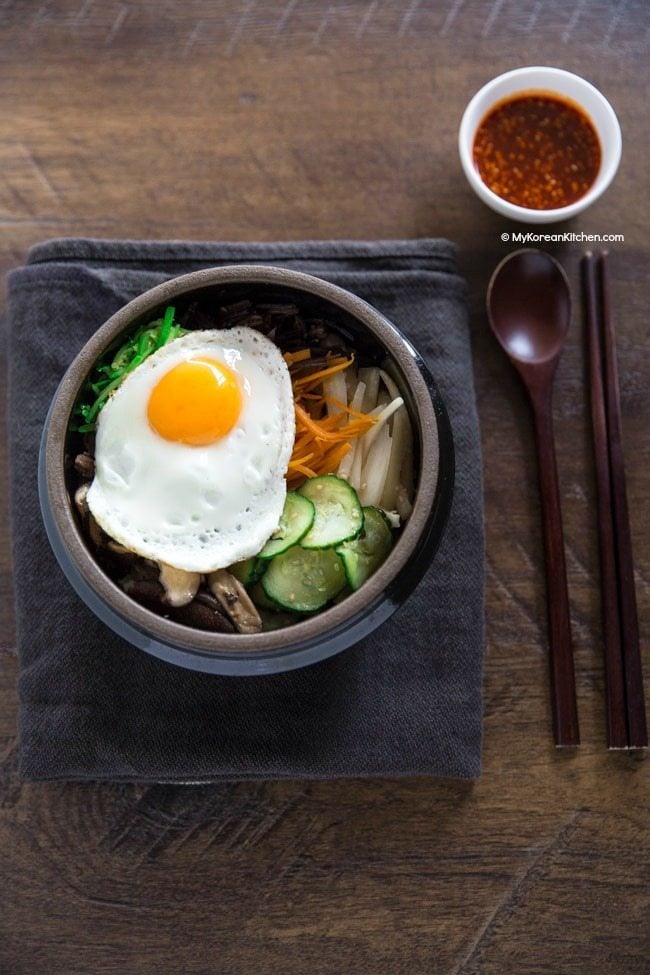
I’m so excited to share my recipe with you today because it’s a dolsot bibimbap kind of a day! Many of you have already enjoyed my super delicious bibimbap recipe over the years and might be wondering, “Why another post about bibimbap?” Well, it’s because I have some amazing new tips to share on how to make dolsot bibimbap, even if you don’t have a dolsot (the Korean hot stone bowl). Isn’t that exciting?
But that’s not all! This time, I’ve added two traditional Korean bibimbap ingredients, gosari namul and doraji namul, to my bowl. If you’ve been following along, you might have noticed my recent recipes for these flavorful namul (Korean vegetable side dishes) over the past few weeks. Now is the perfect time to bring them all together!
Of course, you don’t have to use the exact same sides as me. Bibimbap is wonderfully versatile, so you can get creative with whatever you have in your fridge or pantry. It’s the ultimate leftover-friendly dish that’s as easygoing as it is delicious.
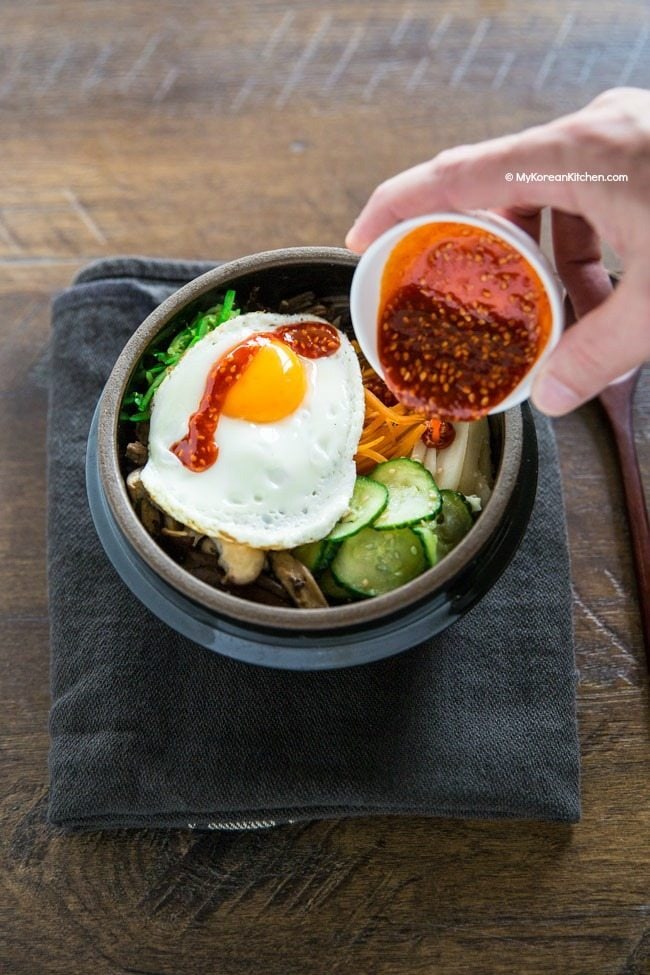
Bibimbap vs. Dolsot Bibimbap
Bibimbap (비빔밥) literally translates to “mixed rice,” and it’s one of the most beloved dishes in Korean cuisine. This hearty meal typically includes rice, an assortment of Korean side dishes (banchan), and a flavorful bibimbap sauce. You can serve it in a standard bowl or a sizzling hot stone bowl, known as a dolsot. Once served, you mix everything together until the ingredients are beautifully combined and then dig in. The result? A dish that’s incredibly delicious and, quite frankly, addictive.
Now, let’s talk about dolsot bibimbap (돌솥 비빔밥). This variation takes bibimbap to the next level by serving it in a hot stone bowl. While some think that all bibimbap is served this way, that’s not the case. The dolsot adds a delightful twist, as the sizzling bowl creates crispy, golden bits of rice at the bottom, adding texture and an irresistible crunch to every bite.
The dolsot itself is versatile and can be made from granite stone, ceramic, or clay. At home, I use a ceramic version that not only makes amazing dolsot bibimbap but also works beautifully for some of Korea’s finest stews, like Soondubu Jjigae (soft tofu stew) and Kimchi Jjigae (kimchi stew). Whether you have a dolsot or not, you can still enjoy bibimbap in its simplest form. But trust me, there’s something magical about the sizzling sound and crispy rice that comes with the dolsot experience.
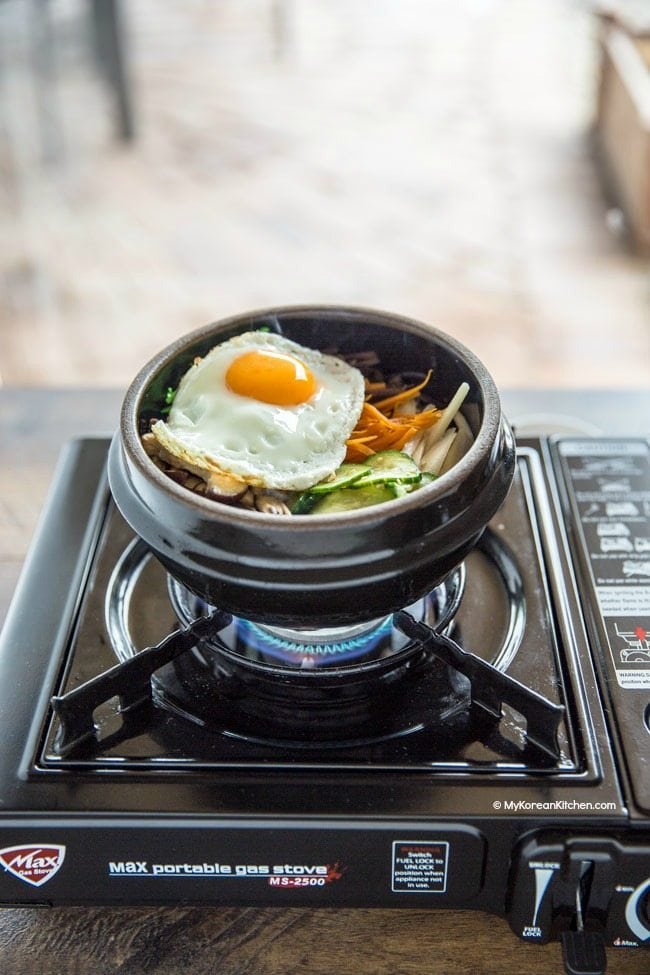
Why Make Bibimbap in a Sizzling Hot Stone Bowl
If you serve bibimbap in a regular bowl, you might notice that the rice cools down pretty quickly. There’s nothing wrong with that, of course. But for some, bibimbap is best enjoyed when everything stays warm, if not piping hot.
That’s where the magic of a hot stone bowl comes in. Preparing and serving bibimbap in one of these sizzling bowls not only keeps your meal warm for longer, but it also creates something extra special: a crispy golden layer of rice at the bottom. That crispy rice, called nurungji (누룽지) in Korean, adds a delightful texture and flavor that takes the dish to a whole new level.
For many people, these little extras make the hot stone bowl experience totally worth it. (And yes, if you’ve noticed dolsot bibimbap is pricier than regular bibimbap in restaurants, now you know why!) It’s more than just a meal—it’s a full-on sensory experience, from the sizzling sounds to that irresistibly satisfying crunch.
Can you see the scorched (slightly burnt) rice in the picture below? Mmmm, it was super crispy. (I probably could have avoided the burnt bits if I hadn’t been too busy snapping photos. Lol #foodbloggermoment)
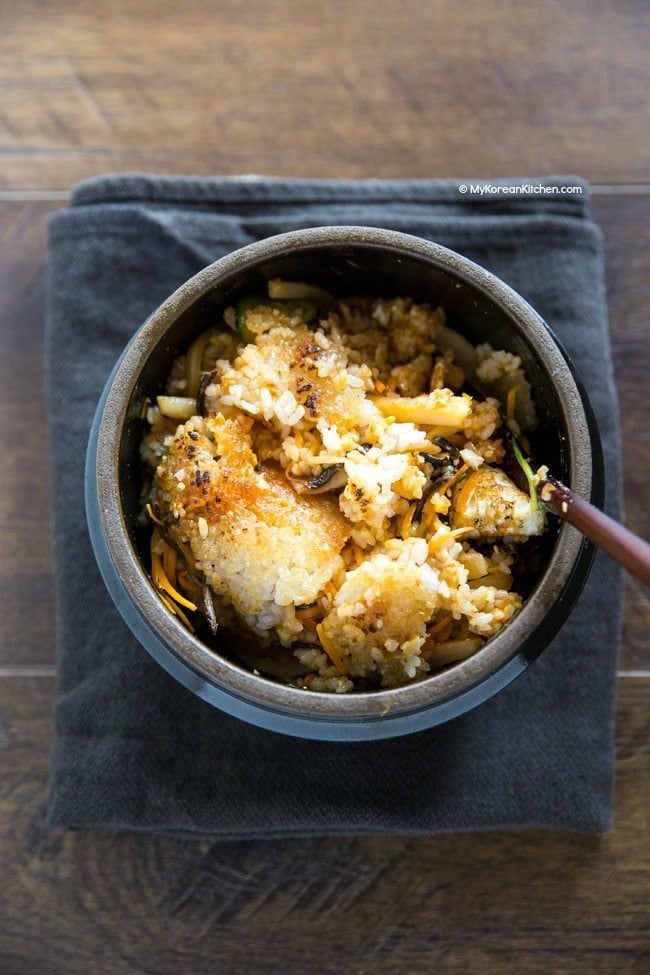
Making Dolsot Bibimbap Without a Hot Stone Bowl
When I used to make bibimbap at home, I’d just serve it in a regular bowl. Why? Because traditional stone or ceramic bowls only work on gas stoves, and I have an induction stove.
Sure, I could pull out my portable gas burner (which I often do for other recipes), but let’s be honest—sometimes I just can’t be bothered. You know those days, right?
Then, a few months ago, I had a lightbulb moment: why not use my trusty cast iron skillet to recreate the “dolsot bibimbap” experience? And let me tell you—it’s a game-changer! Cooking bibimbap in a skillet gives you that signature crispy rice layer, and it’s so much faster and easier.
I’m obsessed with this method, and I think you’ll love it too. Plus, I’ve included a quick demo video below to show you how it’s done!
Watch How to Make Dolsot Bibimbap Without a Stone Bowl!
(Note: The ingredients listed in the video are for 2 servings.)
Now it’s time to learn how to make dolsot bibimbap the authentic way. Enjoy!
Dolsot Bibimbap Ingredients
Meat and Meat Marinade
- 100g / 3.5 ounces rib eye fillets, thinly sliced
- 1 Tbsp soy sauce
- 1 Tbsp sesame oil
- 1 tsp sugar
- 1/4 tsp minced garlic
Vegetables and Other
- 1/2 cups (60 g / 2 ounces) Korean cucumber side dish
- 1/2 cups (60 g / 2 ounces) gosari namul (Korean fernbrake side dish)
- 1/2 cups (60 g / 2 ounces) doraji namul (sautéed bellflower root)
- 1/2 cups (60 g / 2 ounces) carrots, julienned
- 1/2 cups (60 g / 2 ounces) zucchini, julienned
- 1/2 cups (60 g/ 2 ounces) shiitake mushrooms, thinly sliced
- 4 cups steamed rice
- 4 eggs
- some cooking oil – I used rice bran oil
- sesame oil
- fine sea salt
Other Vegetable Ingredients You Could Use
- Korean spinach side dish
- Korean bean sprouts salad
- Daikon radish salad
Dolsot Bibimbap Sauce
- 2 Tbsp gochujang (Korean chili paste)
- 1 Tbsp sesame oil
- 1 Tbsp sugar
- 1 Tbsp water
- 1 Tbsp roasted sesame seeds
- 1 tsp apple cider vinegar (or rice vinegar)
- 1 tsp minced garlic
Note
- Feel free to check out my 3 other bibimbap sauces too!
- If you want to learn more about Korean ingredients, check my essential Korean ingredients list!
- Handle with care while transferring the hot stone bowl.
- 1 Tbsp = 15 ml, 1 Cup = 250 ml
How to Make Dolsot Bibimbap
1. Prepare and cook ingredients as below.
– In a bowl, combine the meat with the marinade. Cover the bowl and leave it in the fridge while you are working on other the ingredients. When ready, Add some cooking oil into a wok and cook the meat on medium high to high heat. It takes about 3 to 5 mins to thoroughly cook it.
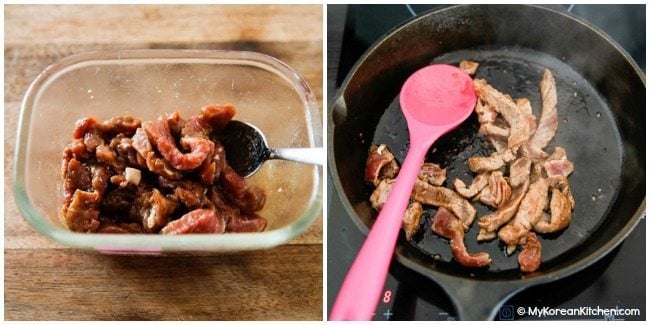
– Prepare the Korean cucumber side dish, fernbrake side dish and bellflower root side dish per the linked recipes. These can be prepared on a different day to save your bibimbap making time.
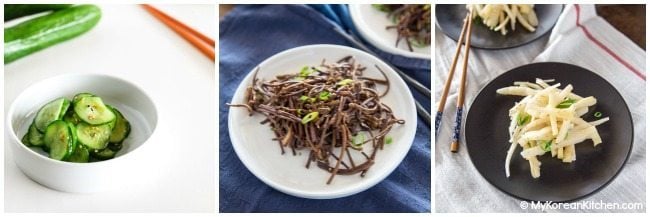
– Separately sauté carrots, zucchini and mushrooms in a frying pan. Season them lightly with fine sea salt.
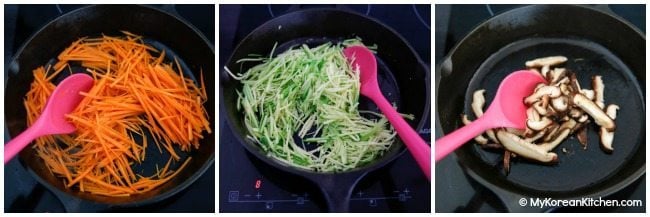
– Mix the bibimbap sauce ingredients in a small bowl. Set aside.
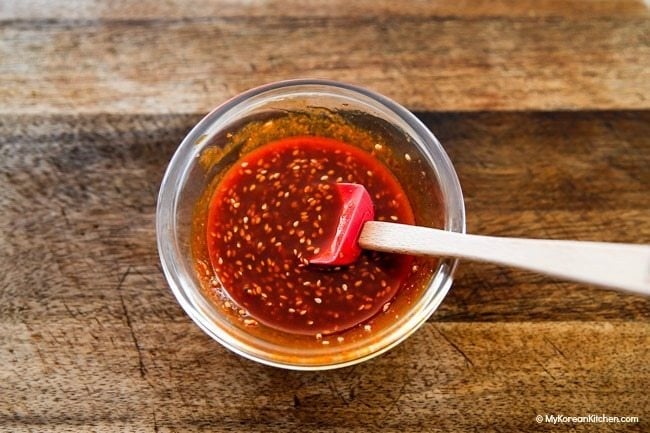
– Pan fry the eggs per your preference. (Sunny side up is a popular choice.)
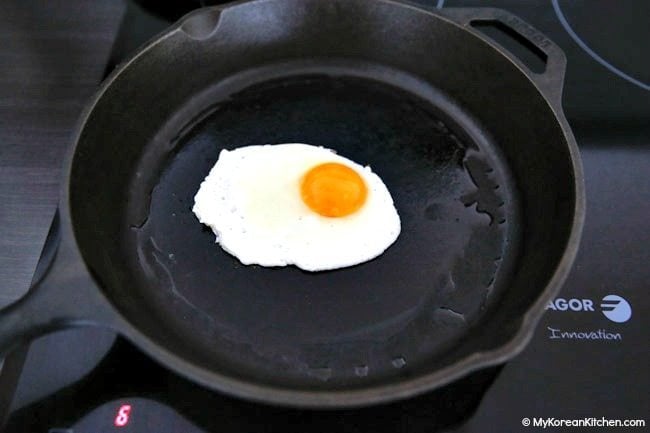
2. Preheat an oven for 10 minutes at 220 C / 428 F. Once heated, place your stone bowl into the oven. Leave it there for 10 minutes. 10 minutes later, take it out. Drop in some sesame oil (about 1 Tbsp per medium size bowl) and brush it around. Quickly assemble your bibimbap ingredients inside the hot stone bowl. First you will have to lay down the rice. Make sure you flatten it well. Then add the meat, assorted vegetables, and the egg on top of the rice. Transfer the hot stone bowl onto the gas stove and cook it for 5 minutes over low heat. You will hear the rice crackling noise. Remove from the heat.
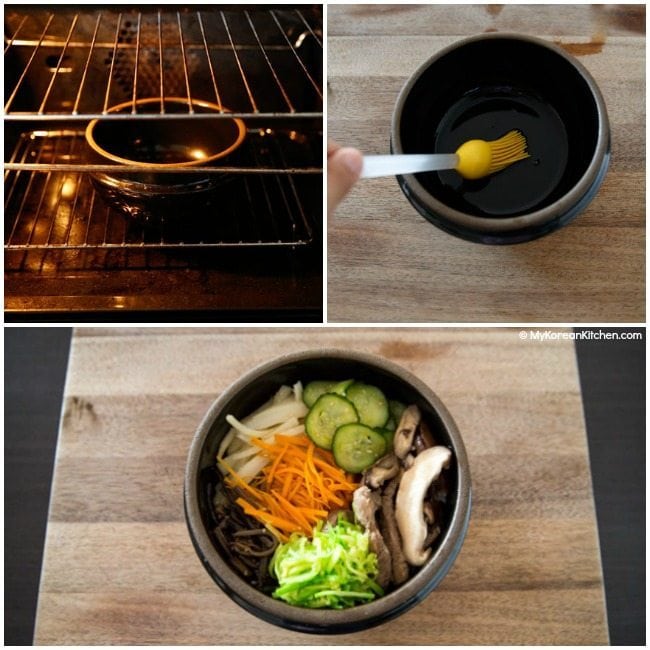
3. Pour the bibimbap sauce into the hot stone bowl and mix all the ingredients well. Serve.
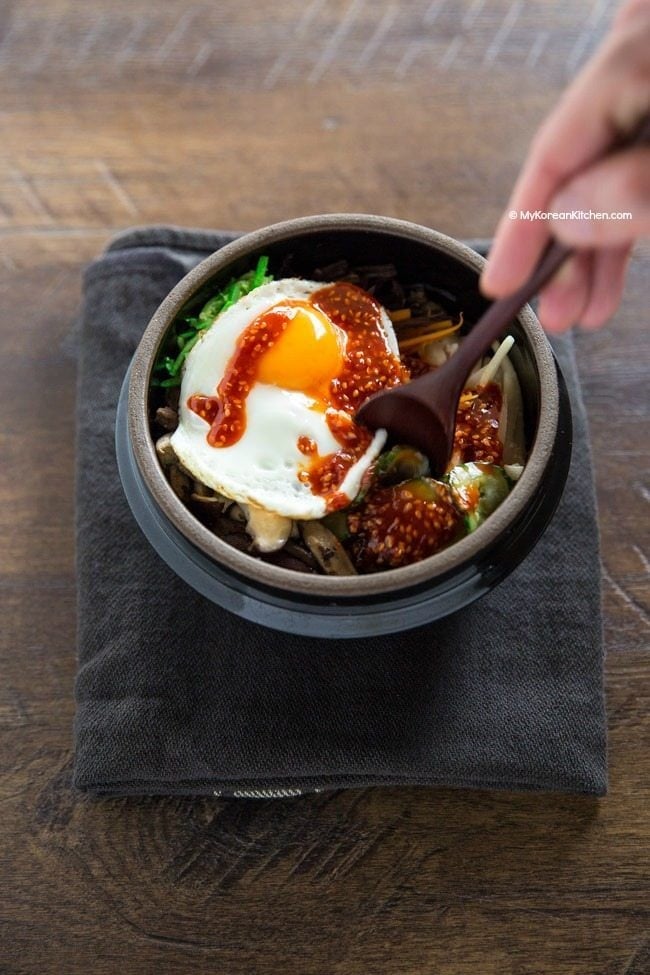

Love Korean Food? Explore our site for authentic Korean recipes—from mastering the art of perfect Korean BBQ at home to creating delicious banchan (Korean side dishes) and other tasty, easy Korean dishes. Let us inspire your next meal!
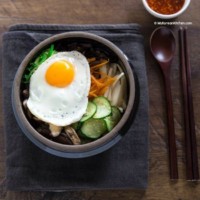
The Best Dolsot Bibimbap Recipe
Ingredients
MEAT AND MEAT MARINADE
- 100 g rib eye fillets (3.5 ounces), thinly sliced
- 1 Tbsp soy sauce
- 1 Tbsp sesame oil
- 1 tsp sugar
- 1/4 tsp minced garlic
VEGETABLES AND OTHER
- 1/2 cup Korean cucumber side dish
- 1/2 cup gosari namul (Korean fernbrake side dish)
- 1/2 cup doraji namul (sautéed bellflower root)
- 1/2 cup carrots , julienned
- 1/2 cup zucchini , julienned
- 1/2 cup shiitake mushrooms thinly sliced
- 4 cups steamed rice
- Some cooking oil , I used rice bran oil
- sesame oil
- fine sea salt
DOLSOT BIBIMBAP SAUCE
- 2 Tbsp gochujang (Korean chili paste)
- 1 Tbsp sesame oil
- 1 Tbsp sugar
- 1 Tbsp water
- 1 Tbsp toasted sesame seeds
- 1 tsp apple cider vinegar (or rice vinegar)
- 1 tsp minced garlic
Instructions
- Prepare and cook ingredients as below.– In a bowl, combine the meat with the marinade. Cover the bowl and leave it in the fridge while you are working on other the ingredients. When ready, Add some cooking oil into a wok and cook the meat on medium high to high heat. It takes about 3 to 5 mins to thoroughly cook it.
– Prepare the Korean cucumber side dish, fernbrake side dish and bellflower root side dish per the linked recipes. These can be prepared on a different day to save your bibimbap making time.
– Separately sauté carrots, zucchini and mushrooms in a frying pan. Season them lightly with fine sea salt.
– Mix the bibimbap sauce ingredients in a small bowl. Set aside.
– Pan fry the eggs per your preference. (Sunny side up is a popular choice.) - Preheat an oven for 10 minutes at 220 C / 428 F. Once heated, place your stone bowl into the oven. Leave it there for 10 minutes. 10 minutes later, take it out. Drop in some sesame oil (about 1 Tbsp per medium size bowl) and brush it around. Quickly assemble your bibimbap ingredients inside the hot stone bowl. First you will have to lay down the rice. Make sure you flatten it well. Then add the meat, assorted vegetables, and the egg on top of the rice. Transfer the hot stone bowl onto the gas stove and cook it for 5 minutes over low heat. You will hear the rice crackling noise. Remove from the heat.
- Pour the bibimbap sauce into the hot stone bowl and mix all the ingredients well. Serve.
Notes
Nutrition Info (per serving)
The nutrition information shown is an estimate provided by an online nutrition calculator. It should not be considered a substitute for a professional nutritionist’s advice.

